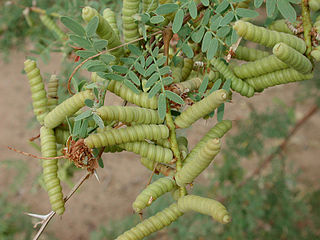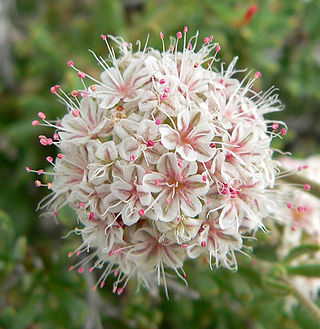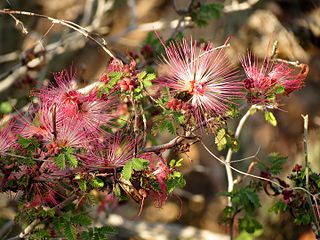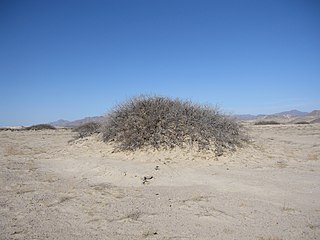
Mesquite is a common name for some plants in the genus Prosopis, which contains over 40 species of small leguminous trees. They are native to dry areas in the Americas. They have extremely long roots to seek water from very far under ground. As a legume, mesquites are one of the few sources of fixed nitrogen in the desert habitat. The trees bloom from spring to summer. They often produce fruits known as "pods". Prosopis spp. are able to grow up to 8 metres (26 ft) tall, depending on site and climate. They are deciduous and depending on location and rainfall have either deep or shallow roots. Prosopis is considered long-lived because of the low mortality rate after the dicotyledonous stage and juveniles are also able to survive in conditions with low light and drought. The Cahuilla indigenous people of western North America were known to eat the seeds of mesquite.

The Chihuahuan Desert is a desert ecoregion designation covering parts of northern Mexico and the southwestern United States. It occupies much of far West Texas, the middle to lower Rio Grande Valley and the lower Pecos Valley in New Mexico, and a portion of southeastern Arizona, as well as the central and northern portions of the Mexican Plateau. It is bordered on the west by the Sonoran Desert, the Colorado Plateau, and the extensive Sierra Madre Occidental range, along with northwestern lowlands of the Sierra Madre Oriental range. Its largest, continual expanse is located in Mexico, covering a large portion of the state of Chihuahua, along with portions of Coahuila, north-eastern Durango, the extreme northern part of Zacatecas, and small western portions of Nuevo León. With an area of about 501,896 km2 (193,783 sq mi), it is the largest hot desert in North America. The desert is fairly young, existing for only 8000 years.

Strombocarpa pubescens, commonly known as screwbean mesquite, is a species of flowering shrub or small tree in the pea family, Fabaceae, that is native to the southwestern United States and northern Mexico.

Eriogonum fasciculatum is a species of wild buckwheat known by the common names California buckwheat and flat-topped buckwheat. Characterized by small, white and pink flower clusters that give off a cottony effect, this species grows variably from a patchy mat to a wide shrub, with the flowers turning a rusty color after blooming. This plant is of great benefit across its various habitats, providing an important food resource for a diversity of insect and mammal species. It also provides numerous ecosystem services for humans, including erosion control, post-fire mitigation, increases in crop yields when planted in hedgerows, and high habitat restoration value.

Neltuma glandulosa, formerly Prosopis glandulosa, commonly known as honey mesquite, is a species of small to medium-sized, thorny shrub or tree in the legume family (Fabaceae).

Prosopis velutina, commonly known as velvet mesquite, is a small to medium-sized tree. It is a legume adapted to a dry, desert climate. Though considered to be a noxious weed in states outside its natural range, it plays a vital role in the ecology of the Sonoran Desert.

Calliandra eriophylla, commonly known as fairy duster, is a low spreading shrub which is native to deserts and arid grasslands in California, Arizona, New Mexico, Texas, and Mexico.

Lycium andersonii is a species of flowering plant in the nightshade family, Solanaceae. Its common names include water-jacket, redberry desert-thorn, Anderson thornbush, Anderson's desert thorn, Anderson boxthorn, Anderson lycium, Anderson wolfberry, and squawberry.

Crossosoma bigelovii, known by the common name ragged rockflower, is one of only a few species in the flowering plant family Crossosomataceae.

Phoradendron californicum, the desert mistletoe or mesquite mistletoe, is a hemiparasitic plant native to southern California, Nevada, Arizona, Sonora, Sinaloa and Baja California. It can be found in the Mojave and Sonoran Deserts at elevations of up to 1400 m.

Ziziphus obtusifolia is a species of flowering plant in the buckthorn family known by several common names, including lotebush, graythorn, gumdrop tree, and Texas buckthorn.

Flourensia cernua is a species of flowering plant in the aster family known by the English common names American tarwort and tarbush and the Spanish common names hojasé, hojasén, and hoja ancha. It is native to the Chihuahuan Desert of North America, where it occurs in the US states of Arizona, New Mexico, and Texas, and the Mexican states of Sonora, Chihuahua, Coahuila, Durango, San Luis Potosí, and Zacatecas. Most of the species in the genus are found in Latin America; this and F. pringlei are the only two species whose ranges extend into the United States.

Lycium pallidum is a species of flowering plant in the nightshade family known by the common names pale wolfberry and pale desert-thorn. It is native to northern Mexico and the southwestern United States. In Mexico it can be found in Sonora, Chihuahua, Zacatecas, and San Luis Potosi. In the United States it occurs from California to Texas and as far north as Utah and Colorado.
Lycium torreyi is a species of flowering plant in the nightshade family known by the common name Torrey wolfberry. It is native to northern Mexico and the southwestern United States from California to Texas.

The Sierra del Carmen, also called the Sierra Maderas del Carmen, is a northern finger of the Sierra Madre Oriental in the state of Coahuila, Mexico. The Sierra begins at the Rio Grande at Big Bend National Park and extends southeast for about 72 kilometres (45 mi), reaching a maximum elevation of 2,720 metres (8,920 ft). Part of the Sierra del Carmen is protected in the Maderas del Carmen Biosphere Reserve as part of a bi-national effort to conserve a large portion of the Chihuahua Desert in Mexico and Texas.

Greasewood is a common name shared by several plants:

A nabkha, nebkha or nebka is a type of sand dune. Other terms used include coppice dune and dune hummock or hummocky dune, but these more accurately refer to similar, but different, sand dune types. Authors have also used the terms phytogenic hillock, bush-mound, shrub-coppice dune, knob dune, dune tumulus, rebdou, nebbe, and takouit.

Eriogonum abertianum, with the common names Abert's buckwheat and Abert wild buckwheat, is a species of flowering plant in the family Polygonaceae.

Clematis drummondii is a species of flowering plant in the buttercup family, Ranunculaceae, that is native to the Southwestern United States and northern Mexico. Common names include old man's beard, Texas virgin's bower, and barba de chivato. It is a white-flowered vine that can be found clambering among other wildflowers, on shrubs and on fence rows. The natural habitat of C. drummondii includes the Chihuahuan and Sonoran deserts as well as prairies and grasslands. The sap of this plant is caustic, although its foliage, stems, and roots can be used for dye if caution is used while handling and if breathing the fumes is avoided.



















